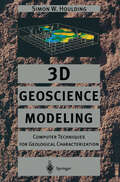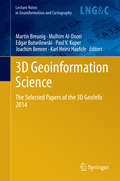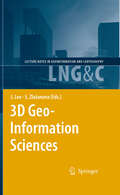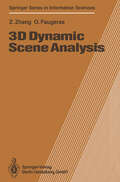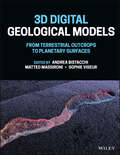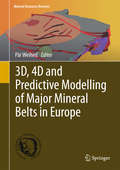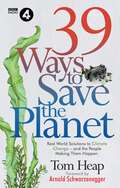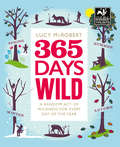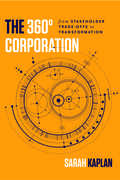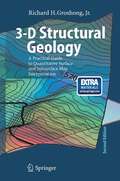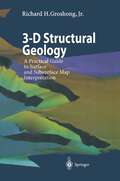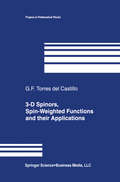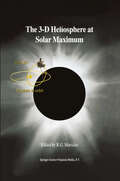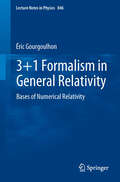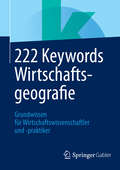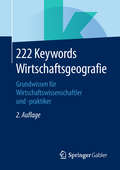- Table View
- List View
3D Geoscience Modeling: Computer Techniques for Geological Characterization
by Simon HouldingThis book is a result of a career spent developing and applying computer techniques for the geosciences. The need for a geoscience modeling reference became apparent during participation in several workshops and conferences on the subject in the last three years. For organizing these, and for the lively discussions that ensued and inevitably contributed to the contents, I thank Keith Turner, Brian Kelk, George Pflug and Johnathan Raper. The total number of colleagues who contributed in various ways over the preceding years to the concepts and techniques presented is beyond count. The book is dedicated to all of them. Compilation of the book would have been impossible without assistance from a number of colleagues who contributed directly. In particular, Ed Rychkun, Joe Ringwald, Dave Elliott, Tom Fisher and Richard Saccany reviewed parts of the text and contributed valuable comment. Mohan Srivastava reviewed and contributed to some of the geostatistical presentations. Mark Stoakes, Peter Dettlaff and Simon Wigzell assisted with computer processing of the many application examples. Anar Khanji and Randal Crombe assisted in preparation of the text and computer images. Klaus Lamers assisted with printing. The US Geological Survey, the British Columbia Ministry of Environment, Dave Elliott and others provided data for the application examples. My sincere thanks to all of them.
3D Geoinformation Science: The Selected Papers of the 3D GeoInfo 2014 (Lecture Notes in Geoinformation and Cartography #94)
by Martin Breunig Mulhim Al-Doori Edgar Butwilowski Paul V. Kuper Joachim Benner Karl Heinz HaefeleNowadays 3D Geoinformation is needed for many planning and analysis tasks. For example, 3D city and infrastructure models are paving the way for complex environmental and noise analyzes. 3D geological sub-surface models are needed for reservoir exploration in the oil-, gas-, and geothermal industry. Thus 3D Geoinformation brings together researchers and practitioners from different fields such as the geo-sciences, civil engineering, 3D city modeling, 3D geological and geophysical modeling, and, last but not least, computer science. The diverse challenges of 3D Geoinformation Science concern new approaches and the development of standards for above- and under-ground 3D modeling, efficient 3D data management, visualization and analysis. Finally, the integration of different 3D approaches and data models is seen as one of the most important challenges to be solved.
3D Geo-Information Sciences (Lecture Notes in Geoinformation and Cartography)
by Jiyeong Lee Siyka ZlatanovaIn recent years 3D geo-information has become an important research area due to the increased complexity of tasks in many geo-scientific applications, such as sustainable urban planning and development, civil engineering, risk and disaster management and environmental monitoring. Moreover, a paradigm of cross-application merging and integrating of 3D data is observed. The problems and challenges facing today’s 3D software, generally application-oriented, focus almost exclusively on 3D data transportability issues – the ability to use data originally developed in one modelling/visualisation system in other and vice versa. Tools for elaborated 3D analysis, simulation and prediction are either missing or, when available, dedicated to specific tasks. In order to respond to this increased demand, a new type of system has to be developed. A fully developed 3D geo-information system should be able to manage 3D geometry and topology, to integrate 3D geometry and thematic information, to analyze both spatial and topological relationships, and to present the data in a suitable form. In addition to the simple geometry types like point line and polygon, a large variety of parametric representations, freeform curves and surfaces or sweep shapes have to be supported. Approaches for seamless conversion between 3D raster and 3D vector representations should be available, they should allow analysis of a representation most suitable for a specific application.
3D Dynamic Scene Analysis: A Stereo Based Approach (Springer Series in Information Sciences #27)
by Zhengyou Zhang Olivier Faugerashe problem of analyzing sequences of images to extract three-dimensional T motion and structure has been at the heart of the research in computer vi sion for many years. It is very important since its success or failure will determine whether or not vision can be used as a sensory process in reactive systems. The considerable research interest in this field has been motivated at least by the following two points: 1. The redundancy of information contained in time-varying images can over come several difficulties encountered in interpreting a single image. 2. There are a lot of important applications including automatic vehicle driv ing, traffic control, aerial surveillance, medical inspection and global model construction. However, there are many new problems which should be solved: how to effi ciently process the abundant information contained in time-varying images, how to model the change between images, how to model the uncertainty inherently associated with the imaging system and how to solve inverse problems which are generally ill-posed. There are of course many possibilities for attacking these problems and many more remain to be explored. We discuss a few of them in this book based on work carried out during the last five years in the Computer Vision and Robotics Group at INRIA (Institut National de Recherche en Informatique et en Automatique).
3D Digital Geological Models: From Terrestrial Outcrops to Planetary Surfaces
by Andrea Bistacchi Matteo Massironi Sophie Viseur3D DIGITAL GEOLOGICAL MODELS Discover the practical aspects of modeling techniques and their applicability on both terrestrial and extraterrestrial structures A wide overlap exists in the methodologies used by geoscientists working on the Earth and those focused on other planetary bodies in the Solar System. Over the course of a series of sessions at the General Assemblies of the European Geosciences Union in Vienna, the intersection found in 3D characterization and modeling of geological and geomorphological structures for all terrestrial bodies in our solar system revealed that there are similar datasets and common techniques for the study of all planets—Earth and beyond—from a geological point-of-view. By looking at Digital Outcrop Models (DOMs), Digital Elevation Models (DEMs), or Shape Models (SM), researchers may achieve digital representations of outcrops, topographic surfaces, or entire small bodies of the Solar System, like asteroids or comet nuclei. 3D Digital Geological Models: From Terrestrial Outcrops to Planetary Surfaces has two central objectives, to highlight the similarities that geological disciplines have in common when applied to entities in the Solar System, and to encourage interdisciplinary communication and collaboration between different scientific communities. The book particularly focuses on analytical techniques on DOMs, DEMs and SMs that allow for quantitative characterization of outcrops and geomorphological features. It also highlights innovative 3D interpretation and modeling strategies that allow scientists to gain new and more advanced quantitative results on terrestrial and extraterrestrial structures. 3D Digital Geological Models: From Terrestrial Outcrops to Planetary Surfaces readers will also find: The first volume dedicated to this subject matter that successfully integrates methodology and applications A series of methodological chapters that provide instruction on best practices involving DOMs, DEMs, and SMs A wide range of case studies, including small- to large-scale projects on Earth, Mars, the 67P/Churyumov-Gerasimenko comet, and the Moon Examples of how data collected at surface can help reconstruct 3D subsurface models 3D Digital Geological Models: From Terrestrial Outcrops to Planetary Surfaces is a useful reference for academic researchers in earth science, structural geology, geophysics, petroleum geology, remote sensing, geostatistics, and planetary scientists, and graduate students studying in these fields. It will also be of interest for professionals from industry, particularly those in the mining and hydrocarbon fields.
3D Digital Geological Models: From Terrestrial Outcrops to Planetary Surfaces
by Andrea Bistacchi Matteo Massironi Sophie Viseur3D DIGITAL GEOLOGICAL MODELS Discover the practical aspects of modeling techniques and their applicability on both terrestrial and extraterrestrial structures A wide overlap exists in the methodologies used by geoscientists working on the Earth and those focused on other planetary bodies in the Solar System. Over the course of a series of sessions at the General Assemblies of the European Geosciences Union in Vienna, the intersection found in 3D characterization and modeling of geological and geomorphological structures for all terrestrial bodies in our solar system revealed that there are similar datasets and common techniques for the study of all planets—Earth and beyond—from a geological point-of-view. By looking at Digital Outcrop Models (DOMs), Digital Elevation Models (DEMs), or Shape Models (SM), researchers may achieve digital representations of outcrops, topographic surfaces, or entire small bodies of the Solar System, like asteroids or comet nuclei. 3D Digital Geological Models: From Terrestrial Outcrops to Planetary Surfaces has two central objectives, to highlight the similarities that geological disciplines have in common when applied to entities in the Solar System, and to encourage interdisciplinary communication and collaboration between different scientific communities. The book particularly focuses on analytical techniques on DOMs, DEMs and SMs that allow for quantitative characterization of outcrops and geomorphological features. It also highlights innovative 3D interpretation and modeling strategies that allow scientists to gain new and more advanced quantitative results on terrestrial and extraterrestrial structures. 3D Digital Geological Models: From Terrestrial Outcrops to Planetary Surfaces readers will also find: The first volume dedicated to this subject matter that successfully integrates methodology and applications A series of methodological chapters that provide instruction on best practices involving DOMs, DEMs, and SMs A wide range of case studies, including small- to large-scale projects on Earth, Mars, the 67P/Churyumov-Gerasimenko comet, and the Moon Examples of how data collected at surface can help reconstruct 3D subsurface models 3D Digital Geological Models: From Terrestrial Outcrops to Planetary Surfaces is a useful reference for academic researchers in earth science, structural geology, geophysics, petroleum geology, remote sensing, geostatistics, and planetary scientists, and graduate students studying in these fields. It will also be of interest for professionals from industry, particularly those in the mining and hydrocarbon fields.
3D, 4D and Predictive Modelling of Major Mineral Belts in Europe (Mineral Resource Reviews)
by Pär WeihedThis book presents the results of the major EU project Promine. For the first time there is now a European database available on mineral deposits, as well as 3D, 4D and predictive models of major mineral belts in Europe: Fennoscandia (Skellefteå and Vihanti-Pyhäsalmi), the Fore-Sudetic basin (Kupferschiefer deposits in Poland and Germany), the Hellenic belt in northern Greece, and the Iberian Pyrite belt and Ossa Morena zone in Spain and Portugal. The book also describes the modelling techniques applied and how different types of software are used for three- and four-dimensional modelling. Furthermore, fundamental descriptions of how to build the database structure of three-dimensional geological data are provided and both 2D and 3D predictive models are presented for the main mineral belts of Europe.
39 Ways to Save the Planet
by Tom HeapWe got ourselves into this. Here's how we can get ourselves out.We know the problem: the amount of biodiversity loss, the scale of waste and pollution, the amount of greenhouse gas we pump into the air... it's unsustainable. We have to do something. And we are resourceful, adaptable and smart. We have already devised many ways to reduce climate change - some now proven, others encouraging and craving uptake. Each one is a solution to get behind.In 39 Ways to Save the Planet, Tom Heap reveals some of the real-world solutions to climate change that are happening around the world, right now. From tiny rice seeds and fossil fuel free steel to grazing elk and carbon-capturing seagrass meadows, each chapter reveals the energy and optimism in those tackling the fundamental problem of our age. Accompanying a major BBC Radio 4 series in collaboration with the Royal Geographical Society, 39 Ways to Save the Planet is a fascinating exploration of our attempt to build a better future, one solution at a time. A roadmap to global action on climate change, it will encourage you to add your own solutions to the list.
365 Ways to Save the Planet: A Day-by-day Guide to Living Sustainably (365 Series)
by Nergiz De BaereARE YOU READY TO CHANGE THE WORLD?365 WAYS TO SAVE THE PLANET is a full year's worth of daily wisdom, carefully selected to inspire you to take the urgent action our very existence desperately needs. You'll find actions and challenges, surprising facts about the climate crisis, templates for writing to political representatives, scientific explanations of important concepts, popular misconceptions about sustainability, and much more. 365 WAYS TO SAVE THE PLANET goes way beyond predictable sustainability advice about how to recycle. Here you'll discover the small stuff you can do every day to change the world. Because when you get the little things right, the big things follow.
365 Days Wild
by Lucy McRobert365 inspirational suggestions for enjoying nature. These 'Random Acts of Wildness' will encourage you to fall in love with, learn about or even help wildlife and wild places near you.
The 360° Corporation: From Stakeholder Trade-offs to Transformation
by Sarah KaplanCompanies are increasingly facing intense pressures to address stakeholder demands from every direction: consumers want socially responsible products; employees want meaningful work; investors now screen on environmental, social, and governance criteria; "clicktivists" create social media storms over company missteps. CEOs now realize that their companies must be social as well as commercial actors, but stakeholder pressures often create trade-offs with demands to deliver financial performance to shareholders. How can companies respond while avoiding simple "greenwashing" or "pinkwashing"? This book lays out a roadmap for organizational leaders who have hit the limits of the supposed win-win of shared value to explore how companies can cope with real trade-offs, innovating around them or even thriving within them. Suggesting that the shared-value mindset may actually get in the way of progress, bestselling author Sarah Kaplan shows in The 360° Corporation how trade-offs, rather than being confusing or problematic, can actually be the source of organizational resilience and transformation.
30 Easy Ways to Join the Food Revolution: A Sustainable Cookbook
by Ollie HunterThis is the first book of its kind to present sustainable eating with a failsafe 30-way recipe plan for readers to follow and cook from.
3 Degrees More: The Impending Hot Season and How Nature Can Help Us Prevent It
by Klaus WiegandtThis open access book describes in detail what life on this planet would be like if its average surface temperature were to rise 3 degrees Celsius above the preindustrial level. On this basis, the book argues that it is imperative to keep this temperature rise below 2 degrees Celsius. It then lays out a detailed plan of what politically feasible, cost-effective measures should now be taken to achieve this goal. In this context, the book provides detailed discussions of climate finance, climate education and nature-based solutions. The book has been translated into English from the original German version published in 2022, and contains an original foreword and preface.
3-D Structural Geology: A Practical Guide to Quantitative Surface and Subsurface Map Interpretation
by Richard H. GroshongThe book includes new material, in particular examples of 3-D models and techniques for using kinematic models to predict fault and ramp-anticline geometry. The book is geared toward the professional user concerned about the accuracy of an interpretation and the speed with which it can be obtained from incomplete data. Numerous analytical solutions are given that can be easily implemented with a pocket calculator or a spreadsheet.
3-D Structural Geology: A Practical Guide to Surface and Subsurface Map Interpretation
by Richard H. GroshongThis is a handbook of practical techniques for making the best possible interpretation of geological structures at the map scale and for extracting the maximum amount of information from surface and subsurface maps. Quantitative methods are emphasized throughout and analytical solutions are given. Interpretation strategies are defined for GIS or CAD users, yet are simple enough to be done by hand. This book will help users produce better geological maps, judge the quality of existing maps, and locate and fix mapping errors.
3-D Spinors, Spin-Weighted Functions and their Applications (Progress in Mathematical Physics #32)
by Gerardo F. Torres del CastilloThis book on the theory of three-dimensional spinors and their applications fills an important gap in the literature. It gives an introductory treatment of spinors. From the reviews: "Gathers much of what can be done with 3-D spinors in an easy-to-read, self-contained form designed for applications that will supplement many available spinor treatments. The book…should be appealing to graduate students and researchers in relativity and mathematical physics." -—MATHEMATICAL REVIEWS
The 3-D Heliosphere at Solar Maximum: Proceedings of the 34th ESLAB Symposium, 3–6 October 2000, ESTEC, Noordwijk, The Netherlands
by R. G. MarsdenOur knowledge of the heliosphere in three dimensions near solar minimum has advanced significantly in the last 10 years, largely as a result of the on-going ESAINASA Ulysses mission. Similar advances in our understanding of the global heliosphere near solar maximum are to be expected with the return of Ulysses to high solar latitudes in 2000/200 I. With this in mind, the 34th ESLAB Symposium, held at ESTEC in Noordwijk, The Netherlands, on 3-6 October, 2000, was devoted to 'The 3-D Heliosphere at Solar Maximum'. This was the third ESLAB Sympo sium focusing on the three-dimensional heliosphere (previous symposia being in 1985 and 1994), and the timing was particularly appropriate, marking as it did the 10th anniversary of the launch of the Ulysses spacecraft. Furthermore, Ulysses had just started its third high-latitude pass, the second over the Sun's south polar regions. The symposium addressed a wide range of topics related to the solar-maximum heliosphere, with presentations on many of the latest findings from Ulysses and other space-based missions. Ground-based studies and theoretical modeling were also well represented. Specific questions to which answers were sought included the following.
3+1 Formalism in General Relativity: Bases of Numerical Relativity (Lecture Notes in Physics #846)
by Éric GourgoulhonThis graduate-level, course-based text is devoted to the 3+1 formalism of general relativity, which also constitutes the theoretical foundations of numerical relativity. The book starts by establishing the mathematical background (differential geometry, hypersurfaces embedded in space-time, foliation of space-time by a family of space-like hypersurfaces), and then turns to the 3+1 decomposition of the Einstein equations, giving rise to the Cauchy problem with constraints, which constitutes the core of 3+1 formalism. The ADM Hamiltonian formulation of general relativity is also introduced at this stage. Finally, the decomposition of the matter and electromagnetic field equations is presented, focusing on the astrophysically relevant cases of a perfect fluid and a perfect conductor (ideal magnetohydrodynamics). The second part of the book introduces more advanced topics: the conformal transformation of the 3-metric on each hypersurface and the corresponding rewriting of the 3+1 Einstein equations, the Isenberg-Wilson-Mathews approximation to general relativity, global quantities associated with asymptotic flatness (ADM mass, linear and angular momentum) and with symmetries (Komar mass and angular momentum). In the last part, the initial data problem is studied, the choice of spacetime coordinates within the 3+1 framework is discussed and various schemes for the time integration of the 3+1 Einstein equations are reviewed. The prerequisites are those of a basic general relativity course with calculations and derivations presented in detail, making this text complete and self-contained. Numerical techniques are not covered in this book.
222 Keywords Wirtschaftsgeografie: Grundwissen für Wirtschaftswissenschaftler und -praktiker
by Springer Fachmedien Wiesbaden GmbHVon der Arrondierung über Footloose Industry und Isolinien bis zur Zeitdistanzmethode: Die Sprache der Wirtschaftsgeografie ist von zahlreichen Fachtermini und Anglizismen geprägt. Einen ersten schnellen Überblick verschafft das vorliegende Nachschlagewerk. Anhand von 222 übersichtlichen Schlüsselbegriffen werden die Grundkonzepte und -theorien der Wirtschaftsgeografie erläutert. Die Erklärungen sind kompakt und verständlich formuliert und bieten somit Basiswissen für alle, die einen schnellen Einstieg suchen, sich für die Grundlagen der Wirtschaftsgeografie interessieren oder ihre vorhandenen Kenntnisse auffrischen möchten.
222 Keywords Wirtschaftsgeografie: Grundwissen für Wirtschaftswissenschaftler und -praktiker
Von der Arrondierung über Footloose Industry und Isolinien bis zur Zeitdistanzmethode: Die Sprache der Wirtschaftsgeografie ist von zahlreichen Fachtermini und Anglizismen geprägt. Einen ersten schnellen Überblick verschafft das vorliegende Nachschlagewerk. Anhand von 222 übersichtlichen Schlüsselbegriffen werden die Grundkonzepte und -theorien der Wirtschaftsgeografie erläutert. Die Erklärungen sind kompakt und verständlich formuliert und bieten somit Basiswissen für alle, die einen schnellen Einstieg suchen, sich für die Grundlagen der Wirtschaftsgeografie interessieren oder ihre vorhandenen Kenntnisse auffrischen möchten.
21st-Century Smallholder: From Window Boxes To Allotments: How To Go Back To The Land Without Leaving Home
by Paul WaddingtonAchieving genuine self-sufficiency of the kind described in John Seymour's classic guide is sadly beyond the vast reach of the urban majority today. Few have the space, and for those few there are comprehensive guidebooks. But where do the rest of us look for the answers to questions like how much effort does it really take to grow your own food? Is beekeeping difficult? Is solar power really worth the bother?From a small terraced house in the middle of a big city, Paul Waddington has made it his business to find out, and while trying it himself, has created a practical and absorbing guidebook along the way. It includes easy-to-read lists, tables, personal anecdote, and stunning illustrations, and more importantly demystifies the subject with practical tips that get to the heart of the matter to show you how you can enjoy the fulfilling aspects of the smallholding life without the hassle and expense of 'going all the way'. If you want to go back to the land without leaving home, this is the perfect guide.
21st Century Maritime Silk Road: Wind Energy Resource Evaluation (Springer Oceanography)
by Chongwei Zheng Hui Song Fang Liang Yi-peng Jin Dong-yu Wang Yu-chi TianThis book aims to establish a wind energy evaluation system, to provide scientific reference for site selection, daily operation and long-term planning of wind power generation, thus to make contribution to breaking the shackles of power shortage. Firstly, it presents the advantages and disadvantages of offshore wind power, then further discusses about the status quo and challenges for wind power programs along the Maritime Silk Road and offer suggestions. A wind energy evaluation system was proposed with the Maritime Silk Road as a case study, including climatic features of wind power (temporal-spatial distribution), long-term climatic trend and mechanism, short-term forecast of wind energy, mid- and long-term projection of wind energy, technology of wind energy evaluation on key point or vital region and offshore wind energy dataset construction, to provide systematic and scientific reference for wind power evaluation and utilization.This book is one of the series of publications on 21st century Maritime Silk Road (shortened as “Maritime Silk Road”). It covers the characteristics of the marine environment and marine renewable energy, remote islands and reefs construction, climate change, early warning of wave disasters, legal escort, marine environment and energy big data construction, etc., contributing to the safe and efficient construction of the Maritime Silk Road. It aims to improve our knowledge of the ocean, thus, to improve the capacity for marine construction, enhance the viability of remote islands and reefs, ease the energy crisis and protect the ecological environment, improve the quality of life of residents along the Maritime Silk Road, and protect the rights, interests of the countries and regions participating in the construction of the Maritime Silk Road. It is a valuable reference for decision-makers, researchers, and marine engineers working in the related fields.
21st Century Maritime Silk Road: Wave Energy Resource Evaluation (Springer Oceanography)
by Chongwei Zheng Jianjun Xu Chao Zhan Qing WangThis book focuses on the evaluation of wave energy in the Maritime Silk Road. Firstly, it compares wave energy and other main energy sources, and then discusses the various disadvantages. It also presents the current research and the difficulties of wave energy evaluation, and systematically analyzes the climatic characteristics of the wave energy, including the temporal–spatial distribution and climatic trend of a series of key factors (e.g. wave power density, availability, richness, stability, energy direction, energy storage). It then describes the design of a short-term forecasting scheme and a long-term projection scheme of wave energy suitable for the Maritime Silk Road, to serve as a plan for the daily operation and long-term development of wave energy. Further, it highlights the wave energy analysis and decision-making in the context of the remote islands and reefs, using Sri Lanka is taken as a case study. Lastly, it presents the first wave energy resource dataset for the Maritime Silk Road.This book is one of a series of publications on the 21st century Maritime Silk Road (shortened as “Maritime Silk Road”) that covers the characteristics of the marine environment and marine new energy, remote islands and reef construction, climate change, early warning of wave disasters, legal escort, marine environment and energy big data construction, contributing to the safe and efficient construction of the Maritime Silk Road. It aims to improve our knowledge of the ocean, and so improve the capacity for marine construction, enhance the viability of remote islands and reefs, ease the energy crisis and protect the ecological environment and improve the quality of life of residents along the Maritime Silk Road, as well as to protect the rights, and interests of the countries and regions participating in the construction of the Maritime Silk Road. This book is a valuable reference resource for decision-makers, researchers, and marine engineers working in the related fields.
21st Century Maritime Silk Road: Construction of Remote Islands and Reefs (Springer Oceanography)
by Chongwei Zheng Chongyin Li Hailang Wu Min WangThis book focuses on the construction of remote islands and reefs in the Maritime Silk Road. Firstly, it analyzes the functions, necessity and difficulties of the construction of remote islands and reefs; then provides corresponding countermeasures. According to the urgent demand of electricity and freshwater, it focus on wave and offshore wind energy evaluation of the important remote islands and reefs of the Maritime Silk Road, providing reference for the choice of location of power plants, daily operation and long term plan of wave/wind power generation. Several important key points are selected in the case study to realize their electricity and freshwater self-sufficiency and thus to improve their viability. This book also presents the marine characteristics (especially hazardous elements) under the demands of island runway construction and marine new energy development, to promote safe and efficient implementation of the remote islands and reefs construction. This book is one of the series of publications on the 21st Century Maritime Silk Road (shortened as “Maritime Silk Road”). It covers the characteristics of the marine environment and marine new energy, remote islands and reefs construction, climate change, early warning of wave disasters, legal escort, marine environment and energy big data construction, etc. contributing to the safe and efficient construction of the Maritime Silk Road. It aims to improve our knowledge of the ocean, thus to improve the capacity for marine construction, enhance the viability of remote islands and reefs, ease the energy crisis and protect the ecological environment, improve the quality of life of residents along the Maritime Silk Road, and protect the rights, interests of the countries and regions participating in the construction of the Maritime Silk Road. It will be a valuable reference for decision-makers, researchers, and marine engineers working in the related fields.
21st Century Maritime Silk Road: A Peaceful Way Forward (Springer Oceanography)
by Chongwei Zheng Ziniu Xiao Wen Zhou Xiaobin Chen Xuan ChenThis book focuses on understanding the characteristics of the marine environment; overall characteristic of the marine resources (especially the marine new energy) and their current utilization; important routes, channels, and ports; and the Maritime Silk Road from the perspective of international law. It also discusses the significance and opportunities of the Maritime Silk Road initiative, analyzes the challenges involved in the construction of the Maritime Silk Road and provides corresponding countermeasures. Based on the above research, this book also proposes to construct a comprehensive application platform for the Maritime Silk Road that will be a practical tool for decision-making. This book is one of the series publications on the 21st century Maritime Silk Road (shortened as “Maritime Silk Road”). This series publications cover the characteristics of the marine environment and marine new energy, remote islands and reefs construction, climate change, early warning of wave disasters, legal escort, marine environment and energy big data construction, etc. contributing to the safe and efficient construction of the Maritime Silk Road. It aims to improve our knowledge of the ocean, thus to improve the capacity for marine construction, enhance the viability of remote islands and reefs, ease the energy crisis and protect the ecological environment, improve the quality of life of residents along the Maritime Silk Road, and protect the rights, interests of the countries and regions participating in the construction of the Maritime Silk Road. It will be a valuable reference for decision-makers, researchers, and marine engineers working in the related fields.
